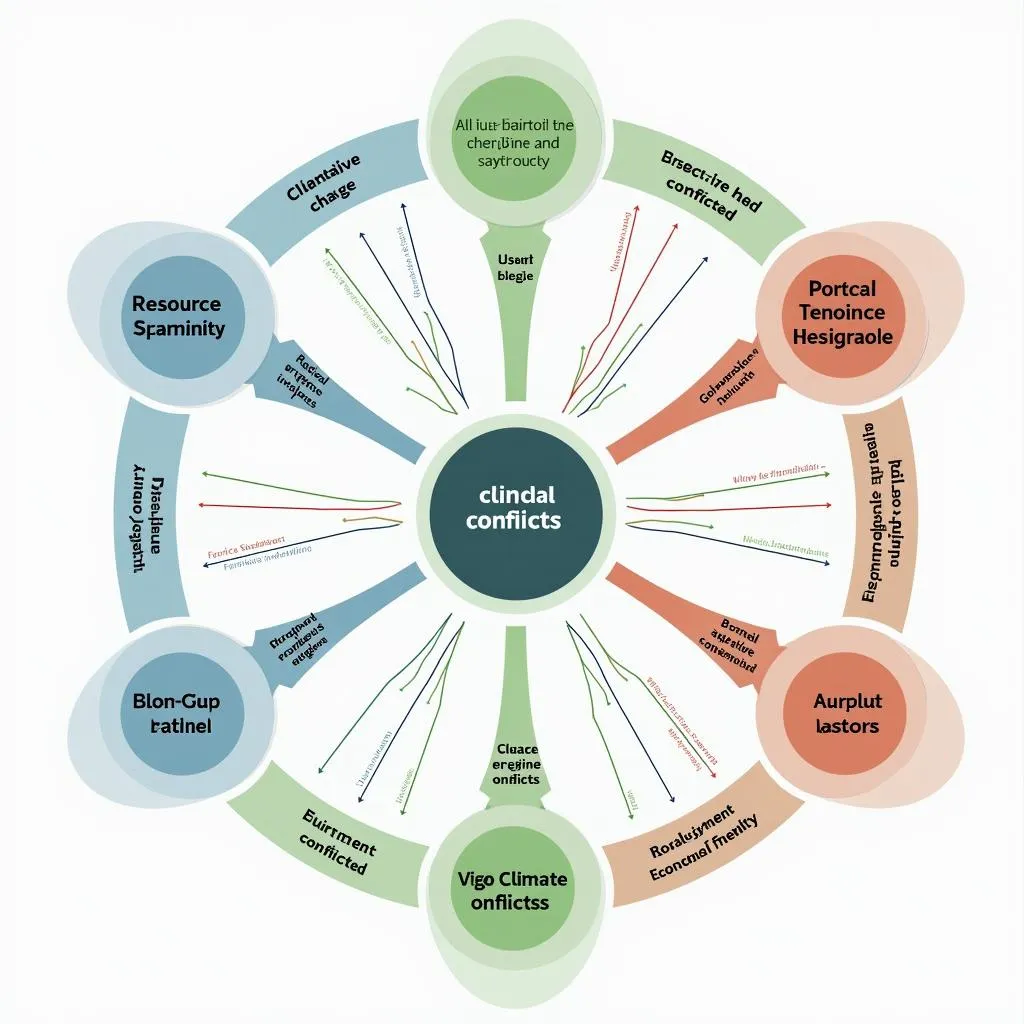The influence of global media on local traditions is a recurring theme in IELTS Writing Task 2. This topic has appeared frequently in past exams and is likely to continue being relevant in future tests. Its popularity stems from the increasing interconnectedness of our world and the ongoing debate about cultural preservation in the face of globalization. Let’s explore this theme through a real IELTS question and provide sample essays for different band scores.
Nội dung bài viết
Some people think that the increasing influence of international media (films, TV, the Internet) is having a negative effect on young people’s cultural identity in many countries. To what extent do you agree or disagree with this opinion?
Analyzing the Question
This question asks for your opinion on whether international media is negatively impacting young people’s cultural identity. Key points to consider:
- The topic: The influence of international media on cultural identity
- The focus: Young people in many countries
- The task: Agree or disagree with the given statement
- The scope: Films, TV, and the Internet as forms of international media
To answer this effectively, you need to:
- Clearly state your position
- Provide reasons and examples to support your viewpoint
- Consider potential counterarguments
- Maintain a balanced approach if you partially agree
Let’s look at sample essays for different band scores.
Sample Essay 1 (Band 8-9)
In today’s interconnected world, the pervasive influence of international media has sparked debates about its impact on young people’s cultural identity. While some argue that this global media presence erodes local traditions, I believe that its effects are more nuanced and can even be beneficial in many ways.
Undoubtedly, exposure to international media can lead to some degree of cultural homogenization. Young people may adopt foreign fashions, music styles, or linguistic expressions, potentially diluting their connection to local traditions. For instance, in many Asian countries, Western pop culture has gained significant traction among youth, sometimes at the expense of traditional art forms. However, this phenomenon should not be viewed solely as a loss, but rather as an evolution of cultural identity.
International media can actually enhance cultural awareness and appreciation. By providing windows into diverse societies, films, TV shows, and online content can broaden young people’s perspectives and foster a more inclusive worldview. This exposure often leads to a renewed interest in one’s own cultural heritage, as individuals seek to understand their roots in a global context. For example, the global popularity of K-pop has not only spread Korean culture worldwide but has also inspired many young Koreans to delve deeper into their traditional music and customs.
Moreover, the internet and social media platforms have become powerful tools for cultural preservation and expression. Young people can now easily access information about their heritage, connect with others who share their background, and actively participate in cultural discussions and activities online. This digital engagement often translates into real-world efforts to maintain and celebrate local traditions, creating a dynamic interplay between global influences and local identity.
In conclusion, while the influence of international media certainly presents challenges to traditional cultural identities, its impact is not inherently negative. Instead, it offers opportunities for cultural exchange, personal growth, and a more nuanced understanding of one’s heritage in a global context. The key lies in fostering critical media literacy among young people, enabling them to navigate this global landscape while maintaining a strong connection to their cultural roots.
(Word count: 309)
 Global media's impact on cultural identity
Global media's impact on cultural identity
Essay Analysis (Band 8-9)
This essay demonstrates excellence in several key areas:
-
Task Response: The essay directly addresses the question, presenting a clear position that acknowledges the complexity of the issue. It provides a balanced view, discussing both potential negative impacts and positive aspects of international media influence.
-
Coherence and Cohesion: The essay is well-structured with a clear introduction, body paragraphs exploring different aspects, and a conclusion. Paragraphs are linked logically, and ideas flow smoothly from one to the next.
-
Lexical Resource: The essay uses a wide range of vocabulary accurately and appropriately. Sophisticated phrases like “pervasive influence,” “cultural homogenization,” and “dynamic interplay” demonstrate a high level of language proficiency.
-
Grammatical Range and Accuracy: The essay showcases a variety of complex sentence structures used accurately. It includes conditionals, relative clauses, and other advanced grammatical features without errors that impede communication.
-
Critical Thinking: The essay goes beyond surface-level analysis, presenting nuanced arguments and considering multiple perspectives. It challenges the premise of the question by suggesting that the impact of international media is not solely negative.
-
Examples: Concrete examples, such as the influence of Western pop culture in Asia and the global impact of K-pop, are used effectively to support the arguments.
This essay would likely score in the Band 8-9 range due to its sophisticated approach to the topic, excellent use of language, and well-developed arguments.
Sample Essay 2 (Band 6-7)
The growing influence of international media on young people’s cultural identity is a topic of much debate. While some people believe it has a negative effect, I think the impact is both positive and negative, depending on how it is managed.
On one hand, international media can lead to a loss of cultural identity. When young people are exposed to foreign movies, TV shows, and online content, they might start to adopt foreign lifestyles and values. This can result in them losing touch with their own traditions and customs. For example, in many developing countries, young people are more interested in Western fashion and music than their own traditional arts.
However, international media can also have positive effects on cultural identity. It can help young people learn about other cultures and become more open-minded. This knowledge can make them appreciate their own culture more. Additionally, the internet allows people to share their culture with others around the world. Many young people use social media to showcase their traditional customs and practices to a global audience.
Moreover, exposure to international media can inspire creativity and innovation within local cultures. Young people might combine elements from different cultures to create something new and unique. This can lead to the evolution of cultural identity rather than its destruction.
In conclusion, while international media does pose some risks to cultural identity, it also offers opportunities for cultural exchange and growth. The key is to find a balance between embracing global influences and preserving local traditions. Education plays a crucial role in helping young people navigate these influences and maintain a strong sense of their cultural roots.
(Word count: 267)
 Youth navigating cultural identity in the age of global media
Youth navigating cultural identity in the age of global media
Essay Analysis (Band 6-7)
This essay demonstrates good writing skills but has some areas for improvement:
-
Task Response: The essay addresses the question and presents a clear position. It considers both positive and negative aspects of international media influence, which is good. However, the arguments could be more fully developed.
-
Coherence and Cohesion: The essay has a clear structure with an introduction, body paragraphs, and a conclusion. Ideas are generally well-organized, but the transitions between paragraphs could be smoother.
-
Lexical Resource: The essay uses a range of vocabulary relevant to the topic. While it’s generally accurate, there’s room for more sophisticated and precise word choices.
-
Grammatical Range and Accuracy: The essay uses a mix of simple and complex sentences. There are no major grammatical errors, but more variety in sentence structures could enhance the writing.
-
Critical Thinking: The essay shows some good critical thinking, especially in considering both sides of the argument. However, the analysis could be deeper and more nuanced.
-
Examples: The essay provides some examples, but they could be more specific and detailed to better support the arguments.
This essay would likely score in the Band 6-7 range. It demonstrates a good understanding of the topic and competent writing skills, but lacks the sophistication and depth of analysis seen in higher band scores.
Key Vocabulary
Here are some important vocabulary items from the essays, along with their definitions:
-
Pervasive (adjective) /pəˈveɪsɪv/: Spreading widely throughout an area or group of people.
-
Homogenization (noun) /həˌmɒdʒənaɪˈzeɪʃn/: The process of making things uniform or similar.
-
Nuanced (adjective) /ˈnjuːɑːnst/: Characterized by subtle shades of meaning or expression.
-
Diluting (verb) /daɪˈluːtɪŋ/: Making something weaker in force, content, or value.
-
Traction (noun) /ˈtrækʃn/: The extent to which an idea, product, etc. gains popularity or acceptance.
-
Heritage (noun) /ˈherɪtɪdʒ/: Valued objects and qualities such as cultural traditions that have been passed down from previous generations.
-
Interplay (noun) /ˈɪntəpleɪ/: The way in which two or more things have an effect on each other.
-
Navigate (verb) /ˈnævɪɡeɪt/: To find a way through, around, or over something complicated or difficult.
-
Evolution (noun) /ˌiːvəˈluːʃn/: The gradual development of something, especially from a simple to a more complex form.
-
Crucial (adjective) /ˈkruːʃl/: Decisive or critical, especially in the success or failure of something.
Conclusion
The influence of global media on local traditions is a complex and multifaceted topic that is likely to remain relevant in IELTS Writing Task 2. To excel in essays on this theme, focus on:
- Presenting a clear and balanced argument
- Using specific examples to support your points
- Demonstrating critical thinking by considering multiple perspectives
- Employing a range of sophisticated vocabulary and grammatical structures
As you prepare for your IELTS exam, consider practicing with similar topics such as:
- The impact of social media on local communities
- The role of technology in preserving cultural heritage
- The effects of tourism on traditional ways of life
- The balance between modernization and cultural preservation
Remember, the key to success in IELTS Writing Task 2 is practice and reflection. Try writing your own essay on this topic and share it in the comments section for feedback and discussion. This active engagement will help you refine your skills and boost your confidence for the actual exam.
The influence of international media on local cultures provides further insights into this topic, exploring how global media shapes cultural identities across different societies. Additionally, understanding how globalization affects cultural preservation in developing countries can offer valuable perspectives for your essays.
For a deeper dive into related subjects, you might want to explore the influence of globalization on youth culture, which examines how young people navigate between global trends and local traditions. Another interesting angle is the influence of global brands on local cultures, which looks at how international companies impact cultural practices and consumer behavior.
Lastly, don’t overlook the effects of cultural globalization on language diversity, as language is a crucial aspect of cultural identity often affected by global media influences. By exploring these interconnected topics, you’ll be well-prepared to tackle a wide range of questions related to global media and cultural traditions in your IELTS Writing Task 2.


